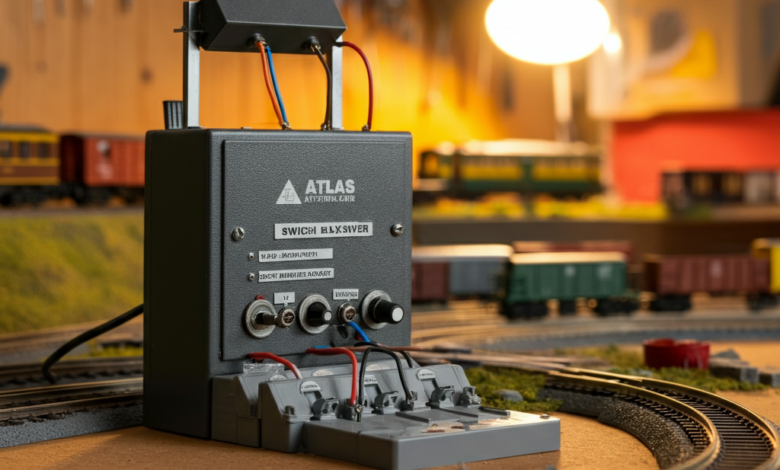Can Atlas Switch Control Boxes Be Used to Power Blocks?

Model railroading is a creative and technical hobby that combines art, engineering, and storytelling. A significant technical aspect of building and operating a model railroad layout involves managing the power distribution across the tracks. Many hobbyists rely on tools like Atlas switch control boxes and power blocks to achieve this.
If you’re wondering whether Atlas switch control boxes can be used to power blocks, this post dives deep into the question. We’ll explore how these tools function, analyze their compatibility, and provide some best practices to help you build a safe and efficient model railway.
Understanding Atlas Switch Control Boxes
Atlas switch control boxes are popular tools for model railroad enthusiasts who use analog DC (Direct Current) systems for their layouts. These compact devices are primarily designed to control the electrical current running to turnouts (also known as switches), allowing hobbyists to change track pathways remotely.
Purpose and Function
The Atlas switch control box typically functions as an intermediary between your track’s wiring system and the turnout motors. You can toggle the control box to send current to the required turnout, allowing it to flip the rail path. This enables smooth direction changes without having to reach directly onto the layout.
Wiring Setup
The standard wiring setup for an Atlas switch control box requires:
- A power source, which could be an AC or DC current.
- Two wires running from the control box to the turnout motor.
- A grounding wire connected to the track system.
The wiring is straightforward, making the control boxes easy to integrate into layouts.
Voltage and Current Limitations
Atlas switch control boxes are primarily designed for low-current applications. For most layouts, the control box will draw power from your model train transformer or auxiliary power source. However, they have limitations in handling high-current loads, as their main focus is turnout control rather than sustaining track-wide power distribution.
Understanding Power Blocks
Power blocks are an essential concept in model railroading for layouts operated with DC power systems. They help isolate sections of the track to ensure efficient power management.
What Are Power Blocks?
Power blocks are essentially individual sections of a model railroad layout that can be powered independently from other sections. By dividing your layout into multiple blocks, you gain better control over train operations and power consumption.
For example:
- You can operate trains on separate tracks with individual controllers.
- You can quickly identify and respond to electrical shorts, as they only impact the isolated section.
Importance of Power Blocks
Managing power through isolation has many benefits:
- Avoiding Shorts: Blocks help prevent electrical shorts from spreading throughout the entire layout, minimizing damage.
- Efficient Power Distribution: If one part of your layout is drawing more power, separating it into a block allows you to allocate power where it’s needed most.
- Multiple Operators: Blocks enable multiple people to control different sections of the layout simultaneously, creating a more dynamic operation.
Wiring Power Blocks
Traditionally, each power block relies on a dedicated set of wires and is powered by a rotary switch, an individual power supply, or connected through a Digital Command Control (DCC) system in modern layouts.
Can Atlas Switch Control Boxes Power Blocks?
The short answer is no, Atlas switch control boxes are not primarily designed to power blocks, and using them in this capacity comes with several challenges and risks. Here’s an analysis:
Electrical Specifications
Atlas switch control boxes are built to handle short bursts of low-current electrical power, suitable for activating turnout motors. Meanwhile, power blocks often require sustained electrical power to drive trains and accessories in that section. The consistent higher current demand of a power block exceeds the capacity of these control boxes.
Potential Risks
Using Atlas switch control boxes to power blocks can lead to:
- Overheating: The control box may overheat if tasked with distributing higher currents over an extended duration.
- Component Damage: Exceeding the electrical tolerances of the switch control box could permanently damage its internal circuitry.
- Unreliable Operations: Since the switch control box isn’t designed for consistent power delivery, you might experience disruptions in train operations within the block.
What They Can Do
While Atlas switch control boxes cannot power blocks directly, they can play a role in controlling power within your blocks. For instance, they can be used to toggle power on and off for sidings or storage tracks within a power block.
Alternatives and Best Practices for Powering Blocks
If you’re looking for reliable methods to power your layout’s blocks, consider these alternatives and best practices:
1. Use Dedicated Power Supplies
One of the most effective ways to power blocks is to assign a dedicated power supply or transformer to each block. This approach ensures consistent power distribution and minimizes the risk of overload.
2. Consider Digital Command Control (DCC)
For larger or more complex layouts, upgrading to a DCC system can simplify power management. With DCC, you can control different trains and accessories on the same track without needing to isolate sections.
3. Rotary Switches for DC Layouts
If you’re committed to DC operation, rotary switches are excellent alternatives for managing power blocks. These switches distribute current from a central transformer to individual blocks efficiently.
4. Follow Safe Wiring Practices
- Use the proper gauge of wiring that matches the current load of your layout.
- Fuse each block to prevent damage in the event of a short circuit.
- Label your wiring to avoid confusion during troubleshooting or modifications.
5. Invest in Circuit Breakers
Circuit breakers can add an extra layer of protection by cutting off the power if a short is detected in a block. This prevents damage to your equipment and keeps the remaining layout operational.
Power Your Layout the Right Way
While Atlas switch control boxes are excellent tools for operating turnouts on your model railroad, they aren’t suitable for powering blocks. Their design and electrical specifications simply can’t sustain the demands of continuous power distribution. Instead, focus on alternatives like dedicated power supplies, rotary switches, or even a DCC system for a more comprehensive approach.



